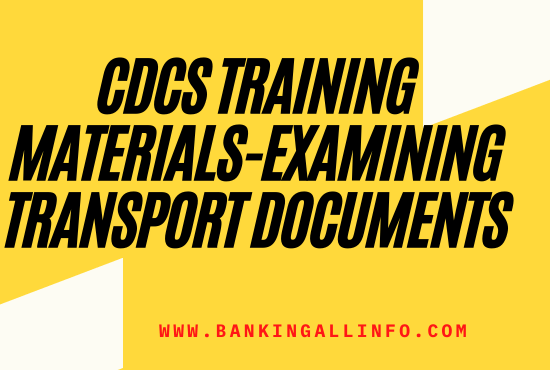CDCS Training Materials-Examining transport documents
Chapter 14
Examining transport documents
Learning objectives
This chapter highlights the requirements when examining transport documents. By the end of this chapter, you should be able to: ◆◆ understand the key examination criteria for transport documents; ◆◆ identify the different characteristics of transport documents; and ◆◆ explain a bank’s examination of documents against the provisions of UCP 600, articles 19–25, and the practices articulated in ISBP 745, sections D–J.
14.1 Transport documents issued by freight forwarders and indication of a goods description
ISBP 745, paragraphs D3(b), E3(b), F2(b) and H3(b) provide the practice that is to be applied when a documentary credit specifically makes mention of the acceptance of a freight forwarder type of transport document.
ISBP 745, paragraph D3(b), relates to multimodal transport documents.
b. When a credit indicates “Freight Forwarder’s Multimodal Transport Document is acceptable” or “House Multimodal Transport Document is acceptable” or words of similar effect, a multimodal transport document may be signed by the issuing entity without it being necessary to indicate the capacity in which it has been signed or the name of the carrier.
ISBP 745, paragraph E3(b), relates to bills of lading.
b. When a credit indicates “Freight Forwarder’s Bill of Lading is acceptable” or “ House Bill of Lading is acceptable” or words of similar effect, a bill of lading may be signed by the issuing entity without it being necessary to indicate the capacity in which it has been signed or the name of the carrier.
ISBP 745, paragraph F2(b), relates to non-negotiable sea waybills.
b. When a credit indicates “Freight Forwarder’s non-negotiable sea waybill is acceptable” or “House non-negotiable sea waybill is acceptable” or words of similar effect, a non-negotiable sea waybill may be signed by the issuing entity without it being necessary to indicate the capacity in which it has been signed or the name of the carrier.
ISBP745, paragraph H3(b), relates to air transport documents.
b. When a credit indicates “Freight Forwarder’s air waybill is acceptable” or “House air waybill is acceptable” or words of similar effect, an air transport document may be signed by the issuing entity without it being necessary to indicate the capacity in which it has been signed or the name of the carrier.
ISBP 745, paragraphs D4, E4, F3 and H4, provide the practice that is to be applied when a documentary credit states that a freight forwarder type transport document is not allowed.
ISBP 745, paragraph D4, relates to multimodal transport documents.
A stipulation in a credit that “Freight Forwarder’s Multimodal Transport Documents are not acceptable” or “House Multimodal Transport Documents are not acceptable” or words of similar effect has no meaning in the context of the title, format, content or signing of a multimodal transport document unless the credit provides specific requirements detailing how the multimodal transport document is to be issued and signed. In the absence of these requirements, such a stipulation is to be disregarded, and the multimodal transport document presented is to be examined according to the requirements of UCP 600 article 19.
ISBP 745, paragraph E4, relates to bills of lading.
A stipulation in a credit that “Freight Forwarder’s Bills of Lading are not acceptable” or “House Bills of Lading are not acceptable” or words of similar effect has no meaning in the context of the title, format, content or signing of a bill of lading unless the credit provides specific requirements detailing how the bill of lading is to be issued and signed. In the absence of these requirements, such a stipulation is to be disregarded, and the bill of lading presented is to be examined according to the requirements of UCP 600 article 20.
ISBP 745, paragraph F3, relates to non-negotiable sea waybills.
A stipulation in a credit that “Freight Forwarder’s non-negotiable sea waybill is not acceptable” or “House non-negotiable sea waybill is not acceptable” or words of similar effect has no meaning in the context of the title, format, content or signing of a non-negotiable sea waybill unless the credit provides specific requirements detailing how the non-negotiable sea waybill is to be issued and signed. In the absence of these requirements, such a stipulation is to be disregarded, and the non-negotiable sea waybill presented is to be examined according to the requirements of UCP 600 article 21.
ISBP 745, paragraph H4, relates to air transport documents.
A stipulation in a credit that “Freight Forwarder’s air waybill is not acceptable” or “House air waybill is not acceptable” or words of similar effect has no meaning in the context of the title, format, content or signing of an air transport document unless the credit provides specific requirements detailing how the air transport document is to be issued and signed. In the absence of these requirements, such a stipulation is to be disregarded, and the air transport document presented is to be examined according to the requirements of UCP 600 article 23.
ISBP 745, paragraphs D26, E22, F20, G20, H22 and J17, provide the practice for indicating a goods description on a transport document.
ISBP 745, paragraph D26, applies to multimodal transport documents.
A goods description indicated on a multimodal transport document may be in general terms not in conflict with the goods description in the credit.


